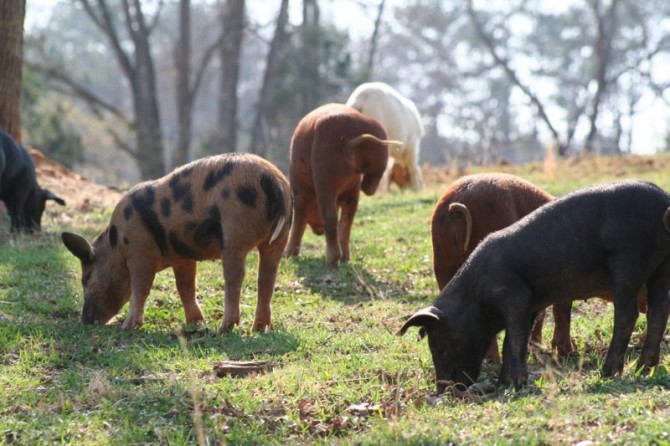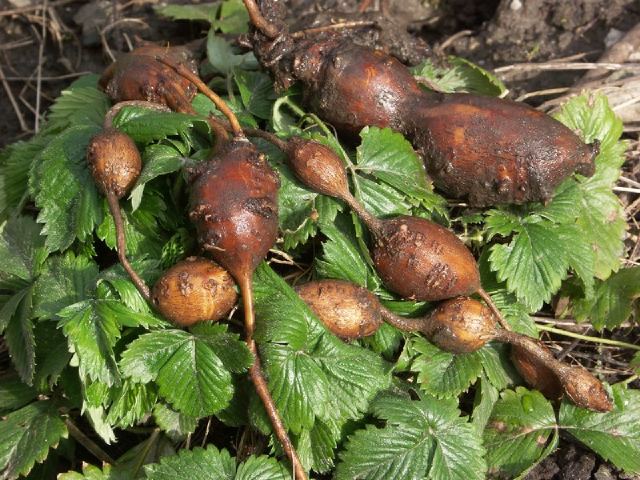 |
| Pastured pigs at a farm in Massachusetts (Image: robbwolf.com) |
This shift in the market is leading to some interesting conceptions of "pastures". We have farmers talking about pastured chickens and pastured pigs, despite neither being capable of actually digesting roughages in pasture the way ruminants such as sheep, goats and cattle will. While chicken is to a degree capable of using pasture, as it will peck at forage grains and soil insects as well as tender sprouts, pigs aren't capable of getting any significant portion of their diet from a conventional pasture.
When left in pasture, a pig's primary behaviour will be to "root" at the soil, unearthing it with their nose, both to create areas to wallow and thermoregulate, and to search for any tasty big bugs and roots that the pig can find. This is the natural behaviour of all pigs, indeed both domestic pigs and boars have a specially evolved bone in their snout for rooting at soil. Farmers have even adapted this behaviour to their advantage in Europe, where trained hogs are used to root for truffles among tree roots.
But this behaviour is disastrous for farmers hoping to stock pigs in their cattle pasture, as the pigs will gradually tear apart the entire pasture and destroy productive forages without eating them. Hogs will rarely get any significant portion of their diet from a conventional pasture; their rooting will provide them with a degree of the minerals required in their diet and the hogs will occasionally eat any larger roots they encounter as well as young sprouts of certain highly palatable annuals like oats.
Just take a look at this simple guide to pig ration building for small producers in New South Wales:
While it is true that pigs love rooting in and eating pasture, they cannot survive on pasture alone. They
need a balanced ration usually based on cereal grain. Pigs are monogastric (single stomach) animals
and are inefficient digesters of fibre (only 50% efficiency).
Diets based on pasture are high in fibre... The more fibre in the diet the lower the digestibility.
Pasture should be 10% or less of their daily intake for best results.
Pigs on a pasture based diet have a reduced dressing % due to the increased gut volume for fibre digestion.
Diets based on pasture are high in fibre... The more fibre in the diet the lower the digestibility.
Pasture should be 10% or less of their daily intake for best results.
Pigs on a pasture based diet have a reduced dressing % due to the increased gut volume for fibre digestion.
Pigs, as monogastrics, have a digestive system very similar to humans. Since we cannot adequately digest roughages, neither can pigs. As farmers it's time to stop stocking our pigs on pastures not designed for them, and keep the roughages for the cow. There are alternatives to pasture building for pigs, that fly in the face of conventional wisdom, that provide far more digestible pasture and better dressing out of your livestock.
A tuber crop pasture will provide your pigs much more useable pasture than simple forages. "Strip-grazing" (leaving your pigs in highly stocked pastures for a single day to forage) of some tuber crops was a once popular here in North America, and today we can improve such systems in either annual or perennial systems.
Annual pastures
If your farm uses pasture as a part of its crop rotation, a perennial pasture will not be your best bet as many perennial tubers are very difficult to eradicate once established and will not be deterred by simply being ploughed under. There are, however, many annual tubers with both agronomic benefits and high digestibility for your pigs.
Daikon (brassica family): this large taproot, related to radishes, is great for its decompacting effect on your soil and its tuber's high digestibility. This crop is a good choice for those of us with more clay-filled soils that don't take well to other tubers, as daikon is very competitive and will drill into less tuber-friendly soil. The young leaves are also fairly digestible for pigs. And whatever tubers are left over, feel free to harvest and eat yourself, this vegetable is a staple throughout East Asia.
Mangelwurzel or Fodder Beet (aster family): related to the red beets we eat, these larger, golden white beets are used primary for livestock feed in Europe. Though it is easily the best yielding of all the crops on this list, it is sensitive to compacted soil and grows best on sandier soils. The tops are not highly digestible to pigs, who will simply tear into the roots, however you may choose to strip-graze your cattle, sheep or goats on the tops at maturity as they are highly digestible to those livestock.
Peanuts (legume family): while not a true tuber, this unique plant we all know flowers aboveground before curling its stems and drilling its fruit below ground to form in safety. As a legume, this crop has the advantage of fixing nitrogen for other crops in your pasture or rotation. However it should not be overstocked as peanut shells are highly fibrous and this will impact the dressing out of your pigs.
Carrots and Parsnips (umbellifer family): these sweet vegetables, while they don't have the yield of the other options on this list, respond very well to muck soils and are an option to consider for those farming black soil. Care must be taken not to overstock these crops, as umbellifer family crops are full of chemicals known as furanocoumarins that can cause rashes and burns when overconsumed raw.
Note that for annual pastures it is not recommended that you sow potatoes. Potatoes, once unearthed by the pig and exposed to sunlight but still in the soil, will begin producing a poisonous chemical known as solanine and turning gradually green. This can cause serious health issues for your pigs and it's recommended that you plant and harvest potatoes yourself for feeding to pigs rather than allowing them to pasture-feed on potatoes.
Perennial pastures
If you intend to dedicate a portion of your land to being permanent pig pasture, it is much more economical to sow perennial tubers rather than the annuals we're more familiar with. All of these perennial tubers are somewhat uncommon crops you won't find in a supermarket, however they are hardy, high-yielding, and perfectly digestible.
Sunchokes or Jerusalem Artichokes (aster family): this little known vegetable is indigenous to eastern North America. A very rustic perennial tuber crop, sunchokes are nearly impossible to eradicate once established, even for your pigs. Sunchokes have a history in North America of being used as strip-grazed pasture for pigs. For pastures of a more permanent nature sunchokes are a primary choice.
 |
| Groundnut tubers (Image: onlyfoods.net) |
Groundnut or Potato Bean (legume family): this vine, also indigenous to eastern North America, produces both edible beans and large strings of edible tubers. As a legume, this crop has the advantage of fixing nitrogen for other crops in your pasture. This crop is somewhat drought-sensitive, so ensure you are planting it in soil where it receives adequate moisture year-round.
Hog peanut (legume family): another vine legume indigenous to eastern North America, like peanuts this crop forms its fruits underground. Both its seed pods and roots are edible, though it does not form large tubers like groundnut. Hog peanut is an option to consider in drier soils where the more sensitive groundnut may not thrive.
Oca or wood sorrel (wood sorrel family): this tuber indigenous throughout the Americas is regularly cultivated in the Andes as a vegetable crop. While high-yielding, oca is frost and moisture sensitive, and is not a good choice for those of us located further north.
Skirret (umbellifer family): a relative of carrots and parsnips indigenous to the UK, this vegetable forms rare fibrous taproots and repopulates itself year after year. Like other umbellifers, skirret are full of chemicals known as furanocoumarins that can cause rashes and burns when overconsumed raw, and so should not be overstocked.



